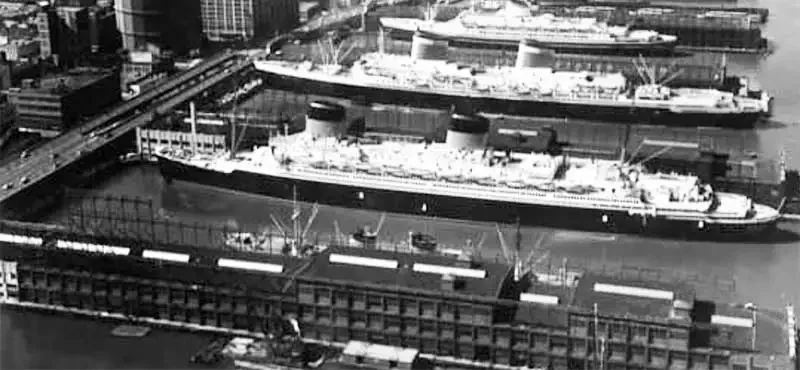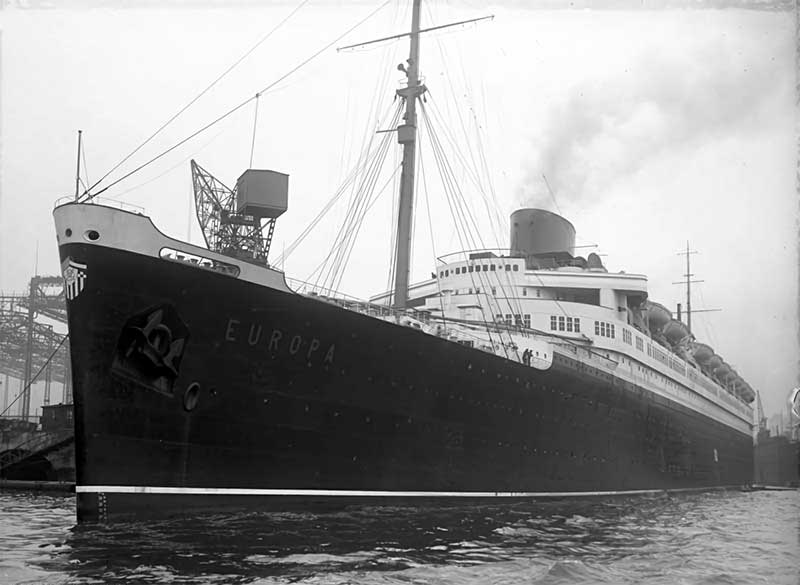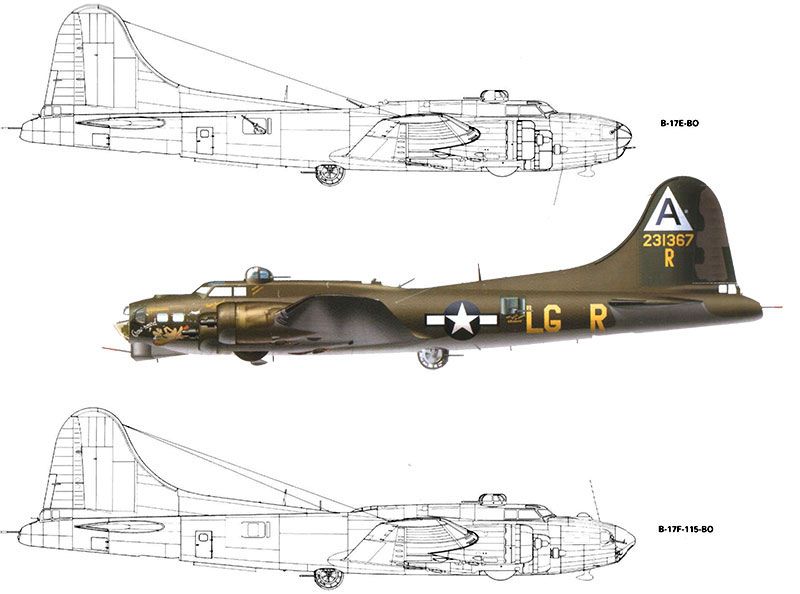- Military Myths, Mysteries, Legends & Curiosities
- Amazing Encounter at Pier 86 (September 1935)

Amazing Encounter at Pier 86 (September 1935) One of the greatest spies in history
In August 1935, Wilhelm Lonkowski and his wife drove to Buffalo, New York, to hold a Treff with Werner Gudenberg, one of his early recruits at Ireland Aircraft. Lonkowski later had used his connections to plant Gudenberg in the Curtiss Airplane and Motor Company in Buffalo, but he had become annoyed with his subagent in recent months.
Gudenberg had been contacting Lonkowski infrequently and had been sending only marginal material clipped from newspapers and aviation magazines. Was he trying to ease out of Nazi espionage?
Gudenberg had been doing well for himself in the American free enterprise system. He was now a supervisor over 35 men and was bringing home a substantial paycheck each week. Along with his attractive wife and infant daughter, Gudenberg was living the good life of any other middle-class American family.
In Buffalo, Lonkowski had hardly begun talking with his subagent when he felt there was a basis for his suspicions. Gudenberg avoided discussing espionage matters, especially when they related to Curtiss Aircraft. But Lonkowski was at his persuasive best. He reminded Gudenberg of the loyalty that all "good Germans" owed to the New Germany, and he recalled the old days in the Fatherland. Clearly, Gudenberg was agonizing over the priority of his loyalties to the Third Reich and to his adopted homeland. But the next day he brought home several Curtiss blueprints for Lonkowski to trace.
A week later, back in Hempstead, Senta de Wanger received a package postmarked Buffalo. With it were instructions for her to take the package to Pier 86, in New York harbor, and turn it over to a Karl Schlueter, a steward on the SS Europa, when she docked in a few days. De Wanger had no way of knowing that Schlüter was the ship's Ortsgruppenleiter (Local Group Leader), the Nazi Party functionary, who had total control of the Europa under the disguise of a steward. An Ortsgruppenleiter could even issue orders to a ship's captain and they had to be obeyed.
At the appointed time, de Wanger boarded the Europa and searched diligently for Karl Schlüter. She asked several ship's officers and crewmen where he could be found, but all were evasive. Finally, the woman abandoned her search. A novice in the espionage business, she carelessly handed the package of military secrets from the Curtiss plant to a sailor and asked that the bundle be turned over to Schlüter.
A few days later, Lonkowski returned home from Buffalo and promptly asked de Wanger about the package. When told that she had handed it to a sailor, Lonkowski flew into a rage.
"I'll kill you!" he roared. ''I'll kill you myself if it falls into the wrong hands!"
De Wanger was petrified. For many days, Lonkowski stayed inside the house and worried. His ulcers were paining him severely. He paced back and forth, cursing and threatening to murder Senta. Each time the phone or doorbell rang, the spy jumped. He was suspicious of a new mail carrier and an electric meter reader. Every few minutes, he peered from behind the curtains to see if anyone was outside.
Then one day, Lonkowski received a letter from Germany, signed with a phony name, but he knew that it was from Karl Schlüter. The message said merely "Order received." Only then did Lonkowski relax.

Pier 86 on the Hudson River in New York was crowded with passengers and their friends on the late afternoon of September 25, 1935, as the luxury liner Europa, pride of the North German Lloyd Line, was about ready to sail for Bremerhaven, Germany. The fast ship had already made a run to her home port and back since Senta de Wanger's issue with the package of aircraft secrets. Morris Josephs, a customs agent, was with the crowd near the vessel when he spotted a thin man carrying a violin case. A Europa steward who had been talking to the man drifted away as the uniformed Josephs approached.
"What kind of violin have you in that case?" Josephs asked pleasantly.
"Oh, just an ordinary fiddle," Wilhelm Lonkowski replied evenly. He shot a quick glance upward just in time to see the "steward" to whom he had been talking, the ship's Ortsgruppenleiter, rushing up the gangway and disappear from view.
"Is that so?" said the Customs agent. "Mind letting me look at it?"
Josephs's request was because of a personal interest in violins, not to a suspicion that this man might be trying to smuggle out goods without paying duty on them. As the Customs agent lifted the instrument from its case, his eyes widened. Under the violin was a collection of papers that looked like photocopies of airplane blueprints.
Josephs replaced the musical instrument, closed the lid, and said, "Will you come with me?"
In the Customs office at the pier, Josephs and John W. Roberts, supervising customs agent for the New York area, searched the spy and found in his pockets film negatives and several letters written in German and addressed to various persons in the Third Reich. The film appeared to show drawings of airplanes, and the letters contained wording that seemed to refer to aircraft specifications. Roberts questioned Lonkowski, who said he was a piano tuner and lived on Long Island. But what was he doing with all those letters and films with the curious drawings? They were simply material to illustrate an article he was doing for the German aviation magazine "Luftreise", for which he worked part time as United States correspondent.
Not knowing what action to take, Roberts phoned Major Stanley Grogan at the Intelligence office for the army's Second Corps Area at Governor's Island in the New York Harbor. Grogan was out, so a private was sent to investigate. He didn't know what to do either, but he managed to locate Major Grogan by phone and gave him a rundown on the situation at Pier 86. An hour later, Grogan arrived at the Customs office, glanced at the detainee, who was seated calmly in a corner, and looked through the materials that were found in the violin case and on Lonkowski himself.
Part of one letter stated: Enclosed you will find an enlargement of the cover for automatic sights of machine guns. Regarding the (unreadable word) ammunition which I am waiting to get from the captain, I still have not received no information. I understand the captain has already contacted von Papen. The captain is a Swiss, although he is in the American infantry.
Major Grogan asked Lonkowski to explain this passage, which seemed like a curious wording for an article in an aviation magazine. Lonkowski remained relaxed and gave confusing answers. Von Papen, he explained, was an infantry captain at Monticello, New Jersey. (A later records check would show that there was no "von Papen" who was an infantry captain in the United States Army.) At another point, the spy said that von Papen "is now in Austria."
The name "von Papen" apparently did not ring a bell with either Grogan or the customs agents. Lonkowski was not asked if his "von Papen" was Colonel Franz von Papen, a Nazi key player and confidant of Adolf Hitler who had gained wide notoriety as the German military attaché in Washington prior to the U.S. entry into World War I. Von Papen had been charged by federal authorities with deliberate and widespread espionage and sabotage activities in America.
Nor did the authorities at Pier 86 seem to know that Colonel von Papen was indeed in Austria (as Hitler's ambassador) where he was spreading Nazi propaganda and creating unrest. Another letter found with Lonkowski indicated that secret military information was being taken from Langley Field, an army air base in Virginia. Part of the letter read: Regarding your inquiry into the construction of bulkheads, etc. of Seversky (Aircraft Corporation) airplane floats. I expect sketches shortly. It will require some time to get the desired information about the water tank at Langley Field.
Other portions of the letters gave evidence that defense secrets were being stolen at other plants or from within the U.S. military establishment: I have just been informed that FLFZ airplanes, which for more than a year were used in the Army and Marine Corps, were authorized for foreign delivery. Please inform me at once if you are still interested in Curtiss X-2 (the navy's supersecret new experimental light bomber).

There were photographs of a new Curtiss fighter plane and of the Voight scout bomber, for use on aircraft carriers. Attached to the photographs were highly technical reports on each airplane's design and capabilities. A bundle of documents told of three new Boeing bombers being inspected by the army and a four-engine bomber, to be known as a B17, or Flying Fortress, that was being designed and built by the Glenn Martin Company in Baltimore. Another new bomber, a note stated, was being designed by the Douglas Aircraft Company from Santa Monica, California.
After an all-night session, Major Grogan and the Customs agents discussed what to do next. They realized that they didn't know the detainee's name. One called across the room, "Hey, fellow, what's your name?"
Lonkowski paused and licked his lips, apparently pondering if he should give an alias. Finally he replied, "William Lonkowski."
"Well, Mr. Lonkowski," Customs agent Roberts said evenly, "you can go now. But be back in three days. We might have a few more questions to ask you."
Casually, Lonkowski put on his hat and, with a pleasant "Good morning, gentlemen" strolled out of the office and onto the pier. His heart was thumping madly, and he fought off an overpowering urge to glance back over his shoulder, to run. Flagging down a cab, Lonkowski jumped inside and sped along streets not yet heavy with rush-hour traffic toward his home on Long Island.
Lonkowski could not believe his good fortune. He had been caught red-handed while loaded down with stolen U.S. military secrets. But these Americans had turned loose one of Nazi Germany's most dangerous and productive spies, without even bothering to take down his address. Lonkowski reached home, drew out all the money in his bank account, burned his codes, pitched a few clothes into a suitcase, and rushed to Dr. Griebl's office in Manhattan. Griebl hid him until late at night, then drove the spy to the physician's summer home outside Peekskill, in suburban Westchester County, New York.
Two mornings later, a pair of operatives from the Office of Naval Intelligence (ONI) were making their routine rounds of the New York waterfront. They ran into customs agent Morris Josephs and were told about the curious event with a violin case that had occurred on the previous Saturday. The ONI men were curious and went to the Customs office on Pier 86, where Lonkowski's pictures, negatives, and letters had been tossed into a drawer.
"Holy smoke!" one navy man exclaimed. "These are naval experimental planes! What happened to the guy who had them?"
The Customs agent shrugged. "G-2, let him go," he replied. Furious, the naval investigator phoned his New York office, which quickly reported the incident to the ONI headquarters in Washington. There Lieutenant Commander Ellis M. Zacharias was ordered to grab a plane to New York and "find out what this mess was all about." Two hours later Zacharias was sitting in the office of the ONI's district director in New York and listening to a tale that he found almost impossible to believe.
Commander Zacharias rushed to Governor's Island to get more details from Major Joseph Dalton, the G-2 (Intelligence). "Major," the naval investigator said, "to me this is a pure case of espionage, and I feel that your people should have communicated immediately with ONI." Dalton was still not convinced. Indifferently, he replied, "Well, it did not seem like much to us!"
Lonkowski hid for four days at Griebl's place outside Peekskill while the physician arranged for the continuation of his flight. Then Griebl sent his own luxury car and a driver to fetch Lonkowski and take him to Canada. The chauffeur was Ulrich Haussmann, a member of Griebl's ring who had been a pilot in the German air force in World War I and was now in the United States under the cover of a reporter for a German magazine. Haussmann drove his passenger to the Canadian border at Rock Island, Vermont. This was the crucial test. No doubt word had been passed on to be on the lookout for the escapee. Both men breathed sighs of relief as a bored U.S. border guard waved them on.
The two spies raced on to Montreal, where they contacted the German consul, who had already been alerted by Commander Erich Pfeiffer in Germany, that Lonkowski was coming. Griebl had notified Pfeiffer. The consul sent Lonkowski to Riviere-de-Loup, a port city on the St. Lawrence River, where a German freighter had just finished unloading. The escapee was smuggled aboard. Already instructed by Pfeiffer to head for the open sea the minute Lonkowski arrived, the skipper raised anchor and sailed for Germany.
In Germany, the Abwehr welcomed Wilhelm Lonkowski as a conquering hero. His 7 year undercover mission in the United States had been a productive one, both for the flood of U.S. military secrets obtained for the Third Reich and for his bank account. As an additional reward for his services to the Führer, Lonkowski was given a top job in the Air Ministry.
- Germany Nazi (1933-1945)
- United States
- {{#owner}}
- {{#url}} {{#avatarSrc}}
{{name}} {{/url}} {{^url}} {{#avatar}} {{& avatar}} {{/avatar}} {{name}} {{/url}} - {{/owner}} {{#created}}
- {{created}} {{/created}}























